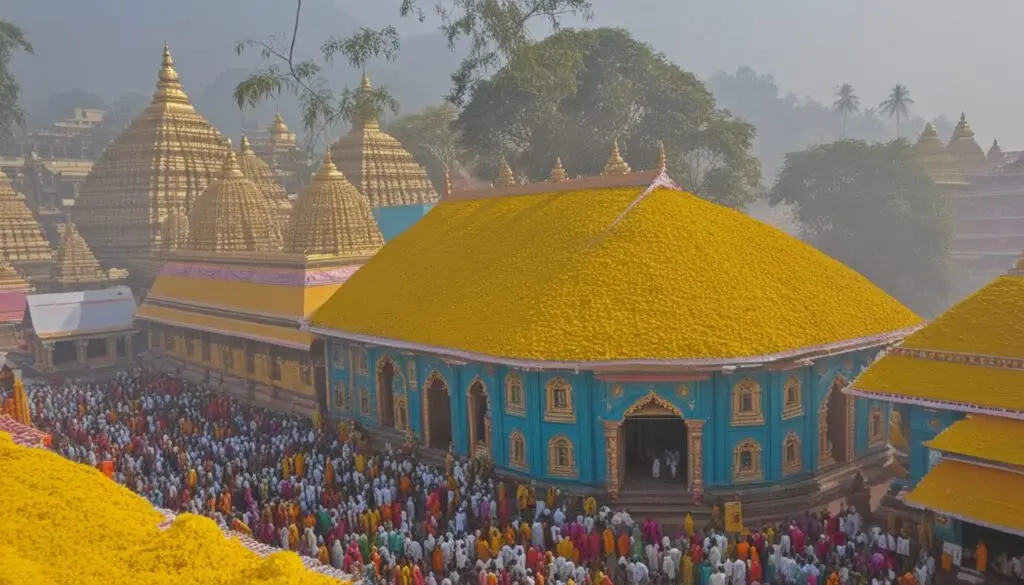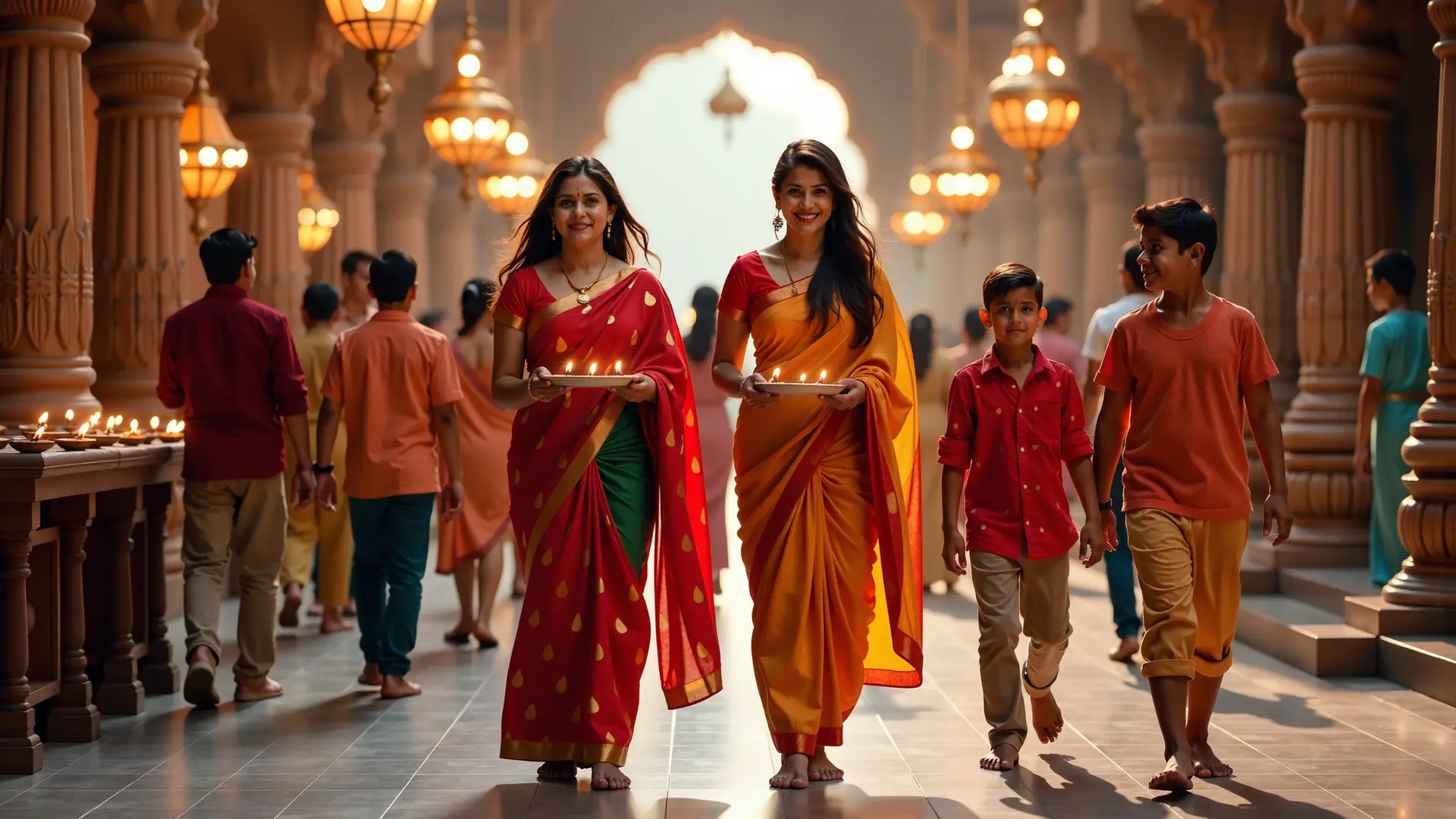
Priest’s Note: This teaching belongs to our Kamakhya GuidePedia. Seek more wisdom in the sacred navigation [🕉️ Kamakhya Temple GuidePedia Navigation 🕉️] below ↓↓↓↓.
Ever wondered what makes the festivals of Maa Kamakhya Devalaya so unique? From the grand Ambubachi Mela to smaller, lesser-known events, each celebration here weaves together spirituality and culture in a spectacular way. In this article, we discuss all major Kamakhya temple festivals, including their scheduled dates for the year 2026, along with a comprehensive list of all events and festivals at Kamakhya, organised month-wise.

Key Information Box
Must-Know Facts About Kamakhya Temple Festivals:
- Ambubachi Mela: Celebrates the fertility of Goddess Kamakhya.
- Manasa Puja: Honors the serpent goddess, Manasa.
- Durga Puja: A grand celebration of Goddess Durga.
- Deodhani Dance Festival: A mesmerizing cultural performance linked to temple rituals.
- Best Time to Visit: June for Ambubachi Mela; September-October for Durga Puja.
Ambubachi Mela: The Grandest Celebration at Kamakhya
The Ambubachi Mela, held annually in June, is the most renowned event at the Kamakhya Temple, attracting devotees, spiritual seekers, and tourists from around the world. The Ambubachi celebration is the most significant of all Kamakhya temple festivals.
- This festival marks the annual menstruation of the goddess, symbolizing fertility and divine energy.
- The temple remains closed for three days, reopening on the fourth day with grand rituals.
- Pilgrims participate in special pujas, chanting, and celebrations to honor the goddess’s powers of creation.
Pro Tip:
Arrive early to secure a spot for darshan after the temple reopens, as the crowds can be overwhelming.
Date:
- The Ambubachi Mela is held every year in June, during the monsoon season.
- Date of Ambubachi Mela 2026: June 22–25, 2026
Manasa Puja: Worship of the Serpent Goddess at Kamakhya
The temple also celebrates Manasa Puja (Manasa Mela), dedicated to the goddess of snakes and protector against snakebites. Manasa Puja is also known as Deodhani or Devadhwani.
- This festival usually occurs in the monsoon months, reflecting the local reverence for nature and its forces.
- Devotees offer milk, flowers, and prayers, seeking blessings for health and safety.
Pro Tip:
This is a quieter celebration, ideal for those who wish to experience the temple in a less crowded but deeply spiritual setting.
Date:
- Manasa Puja starts on the Sravana Sankranti and continues for three days.
- Date of Manasa Puja 2026: August 17th to 20th, 2026
Deodhani Dance Festival: A Unique Tradition
The Deodhani Dance (Deodhani Nritya) Festival is a mesmerizing display of art, culture, and spirituality. Deodhani Nritya is a shamanistic dance performed at the same time as Manasa Puja by persons believed to have been possessed by the spirit of a god or goddess. The dancers are called by local peoples Deodhas, Ghora, or Joki. Each year thousands come to see the Deodhanis perform at the Kamakhya Temple.
- This festival features a traditional dance performed by devotees believed to be possessed by the goddess’s spirit.
- It serves as a vivid portrayal of faith and devotion, drawing curious travelers and devotees alike.
Pro Tip:
Photography during this event is a challenge due to the dynamic performances, so enjoy the spectacle with your eyes rather than through a lens.
Date:
- Deodhani Dance is organised in August every year.
- Date of Deodhani Dance 2026: August 17th to 19th, 2026
Durga Puja: A Festival of Grandeur and Faith
Durga Puja transforms Kamakhya Temple into a vibrant hub of devotion and festivity, and one of the major Kamakhya temple festivals.
- Held during Navratri (September-October), this festival celebrates Goddess Durga as a form of Shakti.
- The temple is adorned with intricate decorations, and special rituals are performed.
- Cultural performances and traditional music add to the joyous atmosphere.
Pro Tip:
Visit during the evening to witness the temple illuminated with lights and the energetic cultural programs.
Date:
- Durga Puja is celebrated in Ashvin, which typically falls in September or October.
- Date of Durga Puja 2026: October 17 – October 21, 2026
Kumari Puja: The Worship of a Virgin Girl
Kumari Puja, or the worship of a virgin girl, is an important part of many Hindu rituals, especially Durga Puja. As per legend, Goddess Kali took the form of a maiden to slay the demon Kolasur, who had seized heaven and earth. During the ritual, a young girl, seen as the embodiment of Goddess Kamakhya, is dressed in red, adorned with ornaments and flowers, and worshipped. The puja symbolizes purity, divine power, and the respect due to womanhood. It is believed to bring blessings and protection to devotees.
- It honors a young virgin girl as a living embodiment of the Goddess, especially Kamakhya or Durga.
- The ritual symbolizes purity and celebrates the divine feminine energy that sustains creation and destruction.
- Devotees believe that performing Kumari Puja brings blessings, prosperity, and protection from evil.
Pro Tip:
Kumari Puja reflects the deep reverence for womanhood and the divine power it embodies. Bring your princess or watch and accompany others who have a princess.
Date:
- Kumari Puja is celebrated on the Maha Ashtami day of Durga Puja, which is in Ashvin (September-October).
- Date of Durga Puja 2026: October 19, 2026
Complete Kamakhya Temple Festivals Calendar
Here is a month-wise summary of the important rituals and festivals celebrated at Kamakhya Temple during the year. This list will help the pilgrims to plan their visit according to the major Kamakhya Temple festivals as well as other traditional Assamese festivities.
April
- Manasha Devi Puthi Opening Ceremony
- Chaitra Sankranti
- Bohag Bihu & Halkhata (Assamese New Year)
May
- Puja of Grammya Devata
June
- Satha Brata
- Ambubachi Mela (the most significant Kamakhya Temple festival)
July
- Daksinayan Sankranti
- Puja of Dakshina Kali Devi
August
- Manasha Devi Puja
- Debaddhani Festival
- Lalita Saptami & Puja of Latitakanta Devi
- Puja of Joyadurga Devi
August / September
- Janmashtami (Birth of Lord Krishna)
- Pitri Tarpan
September
- Manasha Devi Puthi Closing Ceremony
- Biswakarma Puja
September / October
- Nabamyadi Kalparambha
- Sharadiya Durga Puja (from Krishna Navami to Shukla Navami)
October
- Lakshmi Devi Puja
November
- Kartik Puja
November / December
- Dhannya Sedan
- Navanna
December / January
- Puhan Biya (Marriage Ceremony of Devi Kamakhya)
January
- Pousha Sankranti (Makara Sankranti)
- Ratanti Kali Puja
January / February
- Ganesh Puja
- Saraswati Puja
February / March
- Maha Shivaratri
- Gopal Doul (Holi Utsav)
March / April
- Shiva Doul
- Durga Doul
- Basanti Puja
- Raj-Rajaswari Puja (from Chaitra Amavasya to Purnima)
Key Information Recap

- Ambubachi Mela: Celebrates the divine feminine energy in June.
- Manasa Puja: Honors the serpent goddess during monsoon months.
- Durga Puja: A vibrant celebration of Shakti in September-October.
- Deodhani Dance Festival: A cultural and spiritual spectacle.
Conclusion
Maa Kamakhya temple festivals are more than just events; they’re a spiritual journey into the heart of devotion, culture, and tradition. Whether you visit during the bustling Ambubachi Mela or the serene Manasa Puja, every moment spent here is bound to leave you inspired and awestruck. Plan your visit during these celebrations and immerse yourself in the magic of Kamakhya.
Which Kamakhya Temple festival would you love to witness? Let us know in the comments below!
FAQs on Kamakhya Temple Festivals
What are the main festivals celebrated at Kamakhya Temple?
The temple observes an extensive array of festivals and pujas all year round, like the Ambubachi Mela in June, Manasa Puja, Durga Puja, Kumaripuja, and several bratas such as the Satha Brata.
When is the Ambubachi Mela at Kamakhya Temple held?
Ambubachi Mela is held annually in the month of June (Assamese Ahaar month), when the sun transits into Mithuna, and the monsoon is in full swing.
It is a four-day festival: the temple remains closed for three days, opening on the fourth day.
What is the significance of Ambubachi Mela at Kamakhya Temple?
Ambubachi celebrates the annual menstruation-period of the Goddess Kamakhya — symbolising fertility, the earth’s creative power, and the renewal of nature.
This makes the festival unique among Hindu rituals, especially in the Tantric-Shakti tradition.
What rituals take place during Ambubachi Mela at Kamakhya Temple?
The temple remains closed for three days during the festival because it is believed that the Goddess is menstruating. The temple reopens on the fourth day after purification and special pujas. Rituals are accompanied by offerings of red cloth, fruits, vermilion, and singing in praise of the deity. A huge throng of devotees and practitioners of tantra (sadhus, aghoris) come to see and take part.
Are women allowed in Kamakhya Temple during Ambubachi?
I did not find any standard sources that state a blanket ban on women during Ambubachi at Kamakhya. However, since the temple remains closed for three days and opens on the fourth day, the arrangements for visiting may vary. For the latest guidelines, it is best to consult the temple administration.
What other important festivals (besides Ambubachi) are held at Kamakhya Temple and when?
Yes — in the temple calendar:
Durga Puja in September-October (from Krishna Navami to Shukla Navami)
Manasa Puja & Debaddhani Festival (monsoon months)
Kumaripuja (worship of virgin girls) integrated into many of its major festivals.
When is the best time to visit for festivals?
June for Ambubachi Mela, and September-October for Durga Puja.
What is the best time to experience a Kamakhya Temple festival but fewer crowds?
If you desire the spectacle of a full-scale festival, Ambubachi in June is the peak season – expect heavy crowds. Alternatively, for those who wish to enjoy the vibrant ritual atmosphere in a less frenetic setting, visiting just before or after significant festivals like Durga Puja or Manasa Puja may be more suitable. Early morning darshan and off-peak days during the festival can also be considered to avoid large crowds.
Are these Kamakhya Temple festivals open to all visitors?
Yes, all festivals are open to everyone, regardless of their faith.
If you have doubt on whether women (during period) can enter the temple, please check The Kamakhya Paradox – Where the Goddess Bleeds but Women Can’t Enter
What should a pilgrim keep in mind when attending Kamakhya Temple festivals?
Important tips:
1) Book accommodation early during major festivals because pilgrims surge.
2) Check the darshan timings, as during Ambubachi the temple has special closure and reopening times.
3) Dress modestly and be prepared for large crowds and basic amenities (especially in peak festival days).
4) Respect the local customs: you’ll witness traditional rituals and a strong devotional atmosphere.
How crowded is Kamakhya Temple festivals and how safe is it for visitors?
During major festival periods like Ambubachi Mela, hundreds of thousands of devotees arrive (estimates in older sources mention 400,000–500,000). Source: Kamrup Kamakhya
Large crowds mean safety, traffic and accommodation become important concerns. For recent safety updates and crowd-management measures (especially for 2025), check local news/official advisories.
What is the “Rakta Vastra” (or red cloth) and why is it significant at Kamakhya Temple festivals?
In festivals like Ambubachi, red cloth (Rakta Vastra) is often used in the offerings and is considered highly auspicious because it symbolises the creative and cyclical power of the Goddess.
Devotees sometimes receive blessed red cloth or other prasad (sacred offerings) at the reopening of the temple.
Learn more from the Maa Kamakhya Devalaya Offical Website.
🕉️ Kamakhya Temple GuidePedia Navigation 🕉️
Your complete guide to the sacred temple
🛕 Temple Guide 🛕
🏛️ Attractions 🏛️
🏨 Accommodation 🏨
🍽️ Food & Dining 🍽️
✨ Spiritual Secrets ✨
🚗 Guwahati → 5 Gems 🚗
🙏 Explore the divine journey through Kamakhya Temple 🙏



Pingback: Need Silence and Scenic Bliss? Bhubaneswari Temple Is the Ultimate